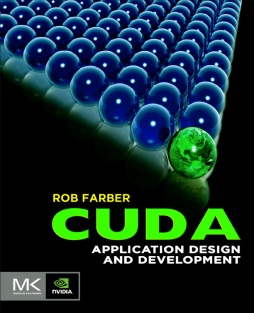
Additional Information
Book Details
Abstract
As the computer industry retools to leverage massively parallel graphics processing units (GPUs), this book is designed to meet the needs of working software developers who need to understand GPU programming with CUDA and increase efficiency in their projects. CUDA Application Design and Development starts with an introduction to parallel computing concepts for readers with no previous parallel experience, and focuses on issues of immediate importance to working software developers: achieving high performance, maintaining competitiveness, analyzing CUDA benefits versus costs, and determining application lifespan.
The book then details the thought behind CUDA and teaches how to create, analyze, and debug CUDA applications. Throughout, the focus is on software engineering issues: how to use CUDA in the context of existing application code, with existing compilers, languages, software tools, and industry-standard API libraries.
Using an approach refined in a series of well-received articles at Dr Dobb's Journal, author Rob Farber takes the reader step-by-step from fundamentals to implementation, moving from language theory to practical coding.
- Includes multiple examples building from simple to more complex applications in four key areas: machine learning, visualization, vision recognition, and mobile computing
- Addresses the foundational issues for CUDA development: multi-threaded programming and the different memory hierarchy
- Includes teaching chapters designed to give a full understanding of CUDA tools, techniques and structure.
- Presents CUDA techniques in the context of the hardware they are implemented on as well as other styles of programming that will help readers bridge into the new material
The book by Rob Faber on CUDA Application Design and Development is required reading for anyone who wants to understand and efficiently program CUDA for scientific and visual programming. It provides a hands-on exposure to the details in a readable and easy to understand form. Jack Dongarra, Innovative Computing Laboratory, EECS Department, University of Tennessee
GPUs have the potential to take computational simulations to new levels of scale and detail. Many scientists are already realising these benefits, tackling larger and more complex problems that are not feasible on conventional CPU-based systems. This book provides the tools and techniques for anyone wishing to join these pioneers, in an accessible though thorough text that a budding CUDA programmer would do well to keep close to hand. Dr. George Beckett, EPCC, University of Edinburgh
With his book, Farber takes us on a journey to the exciting world of programming multi-core processor machines with CUDA. Farber's pragmatic approach is effective in guiding the reader across challenges and their solutions. Farber's broader presentation of parallel programming with CUDA ranging from CUDA in Cloud and Cluster environments to CUDA for real problems and applications helps the reader learning about the unique opportunities this parallel programming language can offer to the scientific community. This book is definitely a must for students, teachers, and developers! Michela Taufer, Assistant Professor, Department of Computer and Information Sciences, University of Delaware
Rob Farber has written an enlightening and accessible book on the application to CUDA for real research tasks, with an eye to developing scalable and distributed GPU applications. He supplies clear and usable code examples combined with insight about _why_ one should use a particular approach. This is an excellent book filled with practical advice for experienced CUDA programmers and ground-up guidance for beginners wondering if CUDA can accelerate their time to solution. Paul A. Navrátil, Manager, Visualization Software, Texas Advanced Computing Center
The book provides a solid introduction to the CUDA programming language starting with the basics and progressively exposing the reader to advanced concepts through the well annotated implementation of real-world applications. It makes a first-rate presentation of CUDA, its use in the implementation of portable and efficient applications and the underlying architecture of GPGPU/CPU systems with particular emphasis on memory hierarchies. This is complemented by a thorough presentation both of the CUDA Tool Suite and of techniques for the parallelisation of applications. Farber's book is a valuable addition to the bookshelves of both the advanced and novice CUDA programmer. Francis Wray, Independent Consultant and Visiting Professor at the Faculty of Computing, Information Systems and Mathematics at the University of Kingston
At a brisk pace, "CUDA Application Design and Development" will take one from the basics of CUDA programming to the level where real-time video processing becomes a stroll in the park. Along the way, the reader can get a clear understanding of how the hybrid CPU-GPU computing idea can be capitalized on, and how a 500-GPU configuration can be used in large scale machine learning problems. Wasting no time on obscure issues of little relevance, the book provides an excellent account of the CUDA execution model, memory access issues, opportunities to increase parallelism in a program, and how advanced profiling can squeeze performance out of a code. Rob provides a snapshot of everything that is relevant in CUDA based GPU computing in a style honed through a long series of Dr. Dobb’s articles that have delighted scores of CUDA programmers. His followers will be delighted once again. Dan Negrut, Associate Professor, University of Wisconsin-Madison, NVIDIA CUDA Fellow
